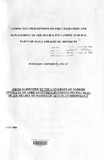| dc.description.abstract | The aspect of sanitation related to the hygienic disposal of human excreta is an important feature of mankind's existence. In Kenya, the majority of the population lives in the rural areas where modem sewerage systems are not available and may continue not to be within the next two decades. Affordable, sustainable, sanitary and rural based technologies are relevant to the majority of the population, including those in the area of study, Nyanza Province. The perception held by people towards an innovation that affects the commonly viewed as personal 'call of nature' is pertinent to its widespread adoption. This study, taking a cross sectional approach, assesses the influence of socio economic, geographical, ecological and cultural factors on the evolution of attitudes towards the double pit latrine in two, rural Luo communities in Nyanza Province. Specifically the voice of the community, their observed behaviour, gender based division of labour and power relations in the technologies' surrounding activities, income, education and occupation are considered both statistically and qualitatively. These considerations are analysed to determine their influence on the evolved perception held by the adopters in Mahanga village in Ugenya, Siaya and those in Kanyajwanga in Kadibo, Kisumu, towards the double pit latrine
Evaluation of these variables are made within the context of the diffusion theory as propounded by Malinowsky and undersigned by the theory of participation as propounded by Robert Chambers in the twentieth century. Malinowsky commonly regarded as the founder of the functional school of thought maintains that human institutions should be examined in the context of their culture as a whole. His theory
explains change from the point of view thai society adopts what is useful to it, and thus allows aspects of an external culture to naturally integrate within another society. The theory of participation on the other hand argues that development will never be sustained if conceived and imported without the involvement of targeted
groups. It suggests that development and change cannot be willed upon people, but requires that people themselves identify their problems and interact with outsiders as partners to seek positive change in their lives. These theories illuminate the issues under study and act as an underlying framework to the hypothesis.
The central hypothesis is used to try the position that culture and perception of the community has hindered the full adoption of the technology under consideration. Alongside this, a hypothesis is used to test the commonly held and widely published view that rural communities adopt sanitation technology for reasons other than health and hygiene. These key issues of attitudinal acceptance, rejection and behaviour, form the basis of study objectives and research questions. In turn, the research questions form the starting point for the investigative tools such as the Focus Group Discussion checklists and standardised questionnaires deployed in the study.
Qualitative and quantitative analysis indicated that due to previous experience, and mode of entry amongst other factors, there has been widespread acceptance of the controversial use and management process of the technology. Notably the concept of reuse of human wastes as farm manure did not present itself as culturally objectionable, although not deliberately previously practised in this culture. The
community is easily categorised as feaco phobic but were seen able to overcome the phobias in meeting a perceived higher, and well identified need.
The motivation of users in adoption lean strongly to the medical and scientific, as well as social and cultural influences, with a stated emphasis on the former. Full diffusion of the double pit latrine is limited however by the material cost of key elements of the technology, in relation to the income levels of the majority of the study population. Finally, the technology has left unchallenged the traditionally defined gender roles, activities and power relations which bear both negative and positive implications on the future construction, management and use of the double pit latrine. In conclusion these findings disprove the central hypothesis that the
technology has not been adopted due to overriding cultural taboo as regards human
waste management in traditional Luo society.
The study brings focus on the urgent issues that arise regarding full fledged sanitation coverage in low income rural areas, chief being the mainstream promotion of more affordable, appropriate technology in difficult conditions. The findings persuade us to build on perceptual and attitudinal strengths concerning sanitation to ensure a wider based diffusion by all sectors of the society in future. Additionally, although modernisation can be forged through external influences, internal gender dynamics must not allow discrimination of certain groups in the community as regards access and control of benefits that are realised during the process of introduction of new technologies. | en |

